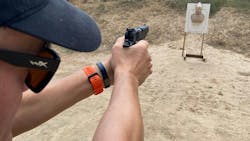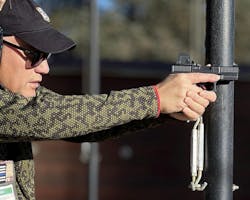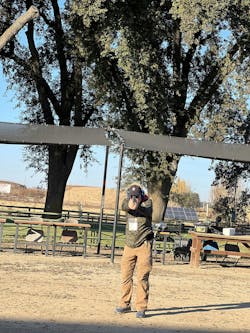Shooting Accurately: Training to Hit the Long Shot
When agencies train with handguns, it is usually within 25 yards. This is within the design intention of the handgun. However, we regularly put ourselves into scenarios that require longer shots. We should train for that.
Longer shots? How do we do that? Imagine the typical high-risk vehicle stop. As a minimum, we try to keep a car vehicle length away for such a stop. If there are multiple Officers involved, this can be 1.5-2 car lengths. Add the distance of the rear of the suspect vehicle to the front passenger compartment, and we are already at 15 yards. Consider the stand off distances we have in active threat scenarios (a classroom from corner to corner can be 15 yards, then add the width of a hallway), or consider the distance between the curb to the front of a house in many urban environments.
Even though statistically the handgun engagement distance is close, if we looked at all of the threat templates out there, officers would carry their carbines everywhere. The truth is, we should be ready for that long shot with a handgun.
Every once in a while, train with your duty gun from 25-50 yards.
Ballistics
My EDC load is the SIG SAUER 9MM, 124GR, ELITE V-CROWN, JHP cartridge. I can shoot it accurately out of all my 9mm guns, including the pocket-sized ones. In my M18 with a 3.9 inch barrel, it has a muzzle velocity around 1165 fps. At 50 yards, the calculated velocity still between 1100-1000 fps. Even after 100 yards, it still is above 1000 fps. Bullet drop is approximately 1” every 10 yards, give or take. This means that, even after 100 yards, a shot aimed at high center mass of a threat is still an effective, and ballistically capable, shot. If you are sitting there with your sniper data thinking cap on, you should know that a 10 mph full value wind at 100 yards will cause very little deflection for this type of shot.
Respiratory Pause
When I taught small arms in the military, the mantra was B.R.A.S.S., This was the acronym for Breathe, Relax, Aim, Slack, and Squeeze. Succinctly, shooters were taught to take a normal breath and let it out, relax the muscles of the body, aim using proper aiming techniques, removing the trigger slack, ( the amount of mechanical slack that has to be overcome before the gun will fire), and squeezing the trigger by steadily increasing the pressure. This mantra was originally developed for precision fire, but it can be easily applied to any type of shooting. Understanding this routine begins with the fact that the preparation for the shot, which is BRASS, and the follow-up from the shot is actually more important than the moment that the person fires the gun. That is, understanding the integrated act of shooting a gun is more about discovering and correcting inconsistencies of shooting.
The breathing part of the shooting requires that the shooter understands the breathing cycle. Most people know that breathing includes inhaling and exhaling. In between and inhale and an exhale is the respiratory pause. The respiratory pause between exhalation and inhalation is actually the moment in time that the body is most relaxed.
The simple concept of respiratory pause breathing is this: if a person times their shot after exhalation, and before inhalation, their shooting will be more consistent. If a shooter practices respiratory pause shooting, they have removed at least one factor from the list of factors that can cause a shot to be misaligned.
Whenever I taught this portion of shooting training, I got asked how a shooter can fire many shots and still be able to accomplish respiratory pause breathing. The short answer is a person can invoke respiratory pause, but not without training. However, simply seeking respiratory pause is enough to improve shooting. The next time you get on the range, learn to exhale, then squeeze the trigger. Eventually, one can induce the cadence of exhaling and squeezing the trigger. It is possible to fire multiple shots after exhalation.
How does one train for this? Use the same training technique that elite forces use to calm their body under extreme stress. It’s called square breathing. Square breathing is a meditation technique that uses the same duration for each side of the breathing cycle. Since there are four sides to a breathing cycle, it is “square”. Begin with five second “sides”. Inhale for five seconds, pause for five seconds, exhale for five seconds, and pause for five seconds. Practice this daily. Eventually, you can work yourself up to 10 second sides.
Besides creating a meditation form, square breathing gives a practitioner awareness of the autonomic parts of bodily functions. Creating relaxed intervals in the body helps settle the body when it is time for action.
Trigger Training and Single Action Shooting
When I teach trigger control to improve accuracy, I always tell shooters to imagine that they are pressing the trigger with their finger in an attempt to touch their nose. That is, the trigger finger should press straight back, not to one side or the other.
In the past two years, there has been a resurgence of single action only handguns, built along the original design of the M1911. The original design has been modernized, like the Staccato line of 2011 handguns, and the Springfield 1911 DS Prodigy Handguns.
I have shot both lines of guns and I can’t decide which products I like better. One thing that Law Enforcement discovered quickly: Many agencies who have adopted these products have reported higher qualification scores. Besides the fact that both Staccato and Springfield Armory use match grade barrels and tight tolerances for these guns, they have much better triggers than most duty guns. Many products boast “match grade triggers” in their guns, but these really are match grade.
I liked the recoil and torque dampening of the Staccato XC frame and the weight and balance of the Springfield Prodigy, but I would rather not be forced to select between the two of them. I like them both. I would put either of them on duty in a minute. When I carry a single action handgun, however, it is a 45, not a 9mm.
The trigger on the modernized single-action design is only one thing. It releases the hammer which ignites the cartridge. Triggers on striker fired guns typically carried on duty retract the striker slightly before the gun is fired. The difference is subtle, but a single-action hammer fired gun is generally easier to steady, and therefore easier to shoot at longer distances. All other things considered, I am more confident in my hostage rescue shot with my 1911 than any other handgun in my inventory.
Optics can be an advantage
An optic generally superimposes a dot or an image over the target. Where the image lies is where the bullet should strike. Because a shooter can maintain target focus without the secondary task of aligning the sights, the target is always in focus when the shooter is engaging. This means that anyone with any type of astigmatism in their vision will have an advantage at longer distances using an optic, provided the dot is superimposed in the focal plane.
I run a Holosun 509, which has a 2 MOA dot inside a 32 MOA circle. If I were shooting a target at longer than normal handgun distances, this is my choice. However, a sighting system on any gun is always a compromise. Sometimes that 2 MOA dot gets washed in bright light on some targets even after adjusting. Some products have dots as large as 8 MOA, which can cover some targets at 25 yards. However, the most common is a 2 MOA sight.
I generally set the optic to 15 yards. Using a 9 mm cartridge, a 15 yard zero will only give a drop around 3.5 inches from that zero at 50 yards.
A RDS is useful when a person struggles with eye dominance, but there really isn’t any significant advantage if a person is trained on iron sights.
Combat sights are for up close
If you examine the sights commonly used on a duty handgun, you’ll find that they have evolved into more than just aiming devices. Many of the better products have hook-like ledges on the leading edge of the rear sight, designed to be used as aid to slide racking. Generally front sights are designed for high visibility, and repeated holster use.
Modern combat sights differ from older handgun sights by their precision and adjustability. If we look at the difference between the size of the front blade and rear notch in today’s handguns, it is rarely more than .1-.125”. As few as 40 years ago, the front sights on most handguns were little slivers, and the rear sights were little trenches. Some experts considered the handgun was suitable for bad breath distances only.
Modern handgun sights are much better quality. Most are adjustable, highly visible, and made with a precision that is constantly improving. The aftermarket sight industry is highly competitive, and consumers are becoming very discerning. This is probably the only upside of governmental permissive lawlessness: the gun industry is very strong, and firearm consumers are becoming more educated.
Because handgun sights are much better, shooting at a further distance is much more attainable.
Shot Follow Through
You’ve already heard a discussion on respiratory pause breathing. This is training and activity before the press of the trigger. The other part of this is activity after the press of the trigger. We call this shot “follow-through”. This is the act of simply maintaining the aim, the breathing pattern, and trigger hold, all the way through the firing cycle. Once the shooter has settled from recoil, the shooting cycle begins again. A discussion on shot follow through and shooting rhythm can be found here: https://www.officer.com/training-careers/specialized-training/article/53057560/shooting-rhythm
How to train
I know that the logical method of training is to take the duty gun to the rifle range and practice there. Let me encourage this. Shooting the gun at longer ranges can improve confidence, and help improve qualification efforts.
Note: I used to tell trainers to maintain qualification scores, but I am “old school” about this. Officers should know how well they are shooting and maintain their own qualification scores. However, the agency qualification transcript of record should just read “pass” or “remediate”. The chances of a qualification score to be used against the agency is relatively low, but it exists. For the sake of discovery, I generally tell trainers to maintain “pass/fail” records for sworn members of an agency.
Training Fleas
As a military small arms trainer, I was the guy with the bad luck who was tasked with pre-qualification and qualification for senior staff officers in the army. In one of my classes, I had 2 general officers, and about a dozen colonels. One of the drills I presented was a 50 yard M9 pre qualification. I am from the “aim small, miss small” training school.
When I was asked why I was having the class fire an M9 (Beretta M9) at 50 yard targets, I dismissed the question with a question of my own: “How does one train fleas?” Since the CSM nearby didn’t tackle me for insubordination, I went on with my explanation. A flea can jump over 90 times their height. When flea circuses were once popular, trainers would put fleas into a Mason jar, close the lid, and leave them there for a week. After that, fleas never jump higher than the lid. Conversely, if a person is given a handgun and trains at 50 yards all the time, 25 yard shooting would seem like “normal”.
When I got done with class, almost everyone shot a perfect score in regular qualification.
About the Author

Officer Lindsey Bertomen (ret.), Contributing Editor
Lindsey Bertomen is a retired police officer and retired military small arms trainer. He teaches criminal justice at Hartnell College in Salinas, California, where serves as a POST administrator and firearms instructor. He also teaches civilian firearms classes, enjoys fly fishing, martial arts, and mountain biking. His articles have appeared in print and online for over two decades.


